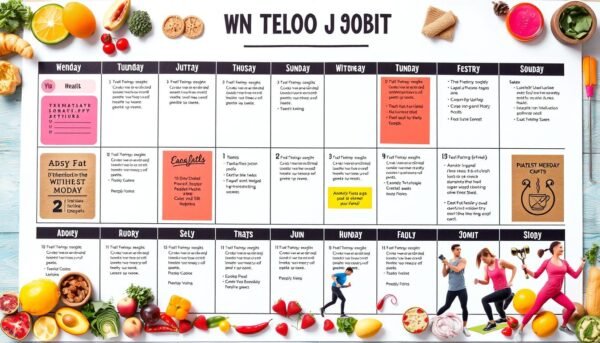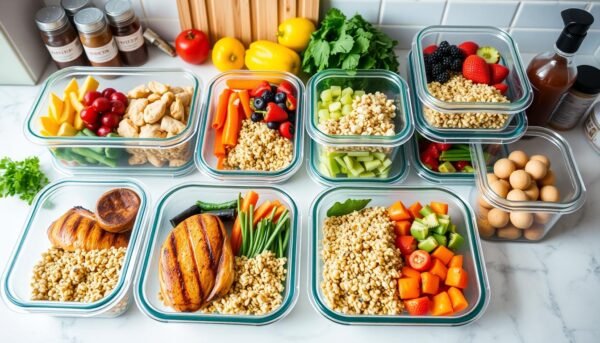Looking in the mirror, I felt frustrated. The extra weight around my belly was a big problem. It hurt my confidence and health. So, I decided to start a 90-day journey to lose belly fat and feel better.
The 90-day diet challenge is a detailed plan for weight loss and belly fat reduction. It changes how we eat to healthier choices and adds exercise for lasting results. It takes about 66 days for new habits to become automatic.
This plan controls calories, balances nutrition, and makes lifestyle changes. It aims for healthy weight loss of 1-2 pounds per week, as the CDC suggests. By eating fewer calories, I’ll lose weight slowly but surely.
I’m excited to start this journey. It will help me reduce abdominal fat and improve my health. Let’s explore the science and strategies for a fitter, happier future together.
Understanding the Science Behind a 90-Day Weight Loss Journey

Starting a weight loss journey can change your life. A 90-day plan is often the best time to see lasting results. It matches the time it takes to form new habits, which is usually 66 days on average.
Why 90 Days is the Optimal Time Frame
A 90-day plan gives you enough time to get used to new habits. You can start eating better and exercising more. This helps you lose weight slowly and safely, as the CDC suggests.
The Psychology of Habit Formation
Working hard for 90 days can help you form good habits. Adding healthy habits like eating right and exercising can make your routine better. This makes losing weight easier and keeps you on track.
Setting Realistic Weight Loss Goals
When you start a 90-day weight loss plan, set goals that are achievable. Aim to lose 0.5 to 1 pound a week. This helps you reach your goal and keep it off for good.
Knowing the science behind a 90-day weight loss plan helps you plan better. You’ll feel more confident and ready to make lasting changes for your health.
Creating Your Personalized Caloric Deficit Strategy

To lose weight and get rid of belly fat, you need a plan. You must find a caloric deficit that fits your life and body. This way, you can burn belly fat fast and lose inches off your waist in 90 days.
Studies say you need to burn 3,500 calories to lose one pound. Cutting 500 calories a day means losing 1 pound a week. Losing 1 to 2 pounds a week is safe and doable. But don’t cut calories too much, or it can slow down your metabolism.
To make your calorie deficit plan, first find your Basal Metabolic Rate (BMR). The Harris-Benedict formula uses your age, sex, height, and weight to figure this out. Then, adjust your daily calories to lose 500 to 1,000 calories a day. This leads to losing 1 to 2 pounds a week.
Your calorie needs change based on how active you are. More active people need more calories. Watching your calorie and protein intake for 3 weeks helps you understand your eating habits. This way, you can make better choices for your calorie deficit plan.
A good calorie deficit plan is key to losing weight in 90 days. By finding the right balance and making it personal, you can burn belly fat fast and lose inches off your waist. And you can do it without harming your health.
Essential Foods That Help lose belly fat

Choosing the right foods is key to losing belly fat. Certain foods can boost your metabolism and support your health. Let’s look at some foods that can help you lose belly fat and reach your fitness goals.
Metabolism-Boosting Proteins
Lean proteins like chicken, turkey, and fish are great for losing weight. They keep you full and boost your metabolism. Studies link high protein diets to less belly fat.
Fiber-Rich Complex Carbohydrates
Fiber-rich foods like whole grains and legumes are good for weight management. They give you energy and keep you full. They may also help reduce belly fat over time.
Healthy Fats for Weight Management
Not all fats are bad. Healthy fats from avocados and nuts can help with weight loss. They regulate hormones and help you feel full.
Green tea, berries, and artichokes are also good for losing belly fat. They boost metabolism and support gut health. Foods like yogurt and kefir are also beneficial.
A balanced weight loss diet with these fat burning foods and metabolism boosters is powerful. It can help you lose belly fat and reach your health and fitness goals.
The Role of Meal Planning and Preparation

Meal planning and preparation are key for losing weight and reducing belly fat. By controlling your meals, you can eat a balanced diet. You can also avoid unhealthy food choices.
Preparing meals at home lets you know exactly what you’re eating. This helps you lose weight more effectively.
Limiting dining out to 2-3 times a week is a good strategy. Restaurants often serve big portions with unhealthy fats and sugars. Meal prep lets you make healthy meals in advance. This way, you always have healthy food options.
- Make a variety of balanced meals with lean proteins, complex carbs, and healthy fats.
- Get ingredients ready for slow-cooker meals to have a healthy dinner after a busy day.
- Keep healthy snacks like nuts, Greek yogurt, and fruits and veggies on hand to avoid unhealthy cravings.
| Meal Prep Tips | Benefits |
|---|---|
| Plan weekly menus with whole grains, lean proteins, and fiber-rich vegetables | Ensures balanced nutrition and supports weight loss |
| Batch cook key ingredients at the beginning of the week | Saves time and allows for variety in meals |
| Keep healthy snacks readily available | Prevents impulsive unhealthy snacking |
By using meal prep for weight loss and healthy meal planning, you can control your nutrition. This helps you lose belly fat and reach your weight loss goals.
Strategic Exercise Combinations for Maximum Fat Burn

To reach your weight loss goals, mix fat-burning exercises wisely. Include both cardio and strength training in your routine. This combo boosts your metabolism, builds lean muscle, and targets belly fat.
Cardio Training Guidelines
Do at least 150 minutes of moderate or 75 minutes of vigorous cardio weekly. Activities like brisk walking, jogging, or cycling work well. High-Intensity Interval Training (HIIT) is also great, with intense exercise followed by rest.
Strength Training Fundamentals
Do strength training two days a week. Use big exercises like squats, deadlifts, and pullups. They work many muscles at once and raise your metabolism. Strength training also builds muscle, which helps burn fat.
Recovery and Rest Periods
Make sure to rest well between workouts. This prevents burnout and lets muscles heal and grow. Have at least one or two rest days weekly and get good sleep for health and fitness.
Combining cardio, strength training, and rest makes a great workout plan. It maximizes fat burning and helps you lose weight. Stay consistent and patient for lasting results.
Hydration and Metabolism Optimization

Drinking enough water is key for losing weight and staying healthy. Try to drink at least 64 ounces of water a day. On hot days or when you’re active, aim for 96 ounces.
Starting your day with water can kickstart your metabolism. Choose water over sugary drinks. Instead, drink water, unsweetened tea, or water with a splash of fruit or cucumber.
Water helps your metabolism and digestion. It also reduces water retention from too much salt. Your body’s energy use and metabolism are influenced by genetics. Your body’s set point also affects your weight.
To boost your metabolism, try the Mediterranean diet. It’s all about plants, healthy fats, and whole grains. Exercise is also key, with at least 150 minutes of activity a week. Standing more can also help prevent obesity and disease.
For personalized advice, talk to a healthcare provider or a dietitian. They can help you reach your weight goals and tackle metabolic issues.
Hydration Tips for Weight Loss
- Aim for a minimum of 64 fluid ounces of water daily, increasing to 96 ounces on hotter days or when exercising.
- Start your day with a glass of water to jumpstart your metabolism.
- Avoid sugary beverages and instead opt for water, unsweetened tea, or water flavored with fresh fruits or cucumber.
- Proper hydration supports metabolism, aids digestion, and can help reduce water retention caused by excess sodium intake.
Metabolism-Boosting Strategies
- Incorporate the Mediterranean diet, which is focused on plant-based foods, healthy fats, and whole grains.
- Engage in regular exercise, combining aerobic activities and resistance training for at least 150 minutes per week.
- Stand more throughout the day to reduce the risk of obesity, diabetes, and heart disease.
- Seek guidance from healthcare providers or registered dietitians for personalized solutions to reach your weight goals and address metabolic challenges.
| Metric | Value |
|---|---|
| Minimum Water Intake (Everyday) | 64 fluid ounces |
| Increased Water Intake (Hot Days/Exercise) | 96 fluid ounces |
| Recommended Weekly Exercise | 150 minutes |
| Females Calorie Intake (19-30 years) | 1,600–2,400 calories per day |
| Males Calorie Intake (19-30 years) | 2,000–3,000 calories per day |
The Impact of Sleep and Stress Management

Quality sleep and managing stress are key for losing weight. Not sleeping well can mess with hunger hormones, making you want to eat more. Stress can also make your body hold onto belly fat. By fixing these issues, you can lose weight better.
Quality Sleep Strategies
Try to sleep 7-9 hours each night. Stick to a sleep schedule and have a calming bedtime routine. Turn off screens and keep your room cool, dark, and quiet. If sleep is hard, try supplements or talk to a doctor.
Stress Reduction Techniques
It’s important to manage stress for your hormones. Do things like meditate, practice yoga, or breathe deeply. These can lower stress hormones and help you lose weight.
Hormonal Balance Tips
Your diet, exercise, and lifestyle affect hormones like cortisol and insulin. Eat well, exercise often, and sleep enough for a healthy balance. Omega-3 fatty acids can also help.
Focus on good sleep, stress management, and hormonal balance for weight loss. Adding these to your 90-day plan can boost your weight loss journey.
Tracking Progress and Making Adjustments

Tracking your progress is key for weight loss. Use a mix of methods like weighing, measuring, and taking photos. But, don’t just look at the scale. It doesn’t show body changes.
Keep going with your weight loss plan and adjust as needed. If you hit a wall, check your diet, move more, or change your meals. Remember, losing weight isn’t always steady. Stay consistent and patient for lasting results.
To track your progress well:
- Weigh yourself regularly, preferably at the same time each day, and record the average weight at the end of each week.
- Take weekly body measurements, such as your waist, hips, and thighs, to track changes in your body composition.
- Capture monthly progress photos, ensuring consistent lighting and positioning, to visually document your transformation.
- Log your dietary adherence as a percentage of your total calorie intake to identify areas for improvement.
By watching your progress and tweaking your plan, you’ll reach your weight loss goals. You’ll find a healthier, more confident you.
Common Obstacles and Solutions During Your Journey

Starting a weight loss journey is exciting but also tough. You might face many challenges on your way to fitness goals. Let’s look at common problems and find ways to solve them.
Overcoming Weight Loss Plateaus
Reaching a weight loss plateau can be really frustrating. It happens when you don’t see weight loss despite hard work. Here are some tips to get past this:
- Try new exercises or make your workouts harder.
- Check your diet and make sure you’re eating fewer calories.
- Consider trying intermittent fasting to boost your metabolism.
Navigating Social Situations Involving Food
Going to social events and eating out can be hard for a healthy lifestyle. Here are some tips to help:
- Eat a small, healthy meal before going out to avoid too much food.
- Look for healthy choices on menus and watch your portion sizes.
- Say no to unhealthy foods and drinks, and enjoy the company more.
Maintaining Motivation Throughout the Journey
Keeping motivation up is a big challenge. Here are some ways to stay motivated:
- Set goals that aren’t just about weight loss, like getting fitter or stronger.
- Celebrate every small win to keep a positive outlook.
- Be around people who support and encourage you.
Remember, losing weight is a journey with ups and downs. See these challenges as chances to learn and grow. With hard work and a balanced approach, you can beat any obstacle and become a healthier, happier you.
Maintaining Motivation Throughout the 90 Days
Starting a weight loss journey is hard. Keeping motivation for 90 days is even tougher. But, with the right mindset and strategies, you can do it. Focus on small, achievable goals to celebrate along the way, not just the end goal.
Tracking your progress is key, not just the scale. Write down your non-scale victories like more energy, better clothes, or a better mood. These small wins can really help when you feel down.
Visualization is a powerful tool for staying motivated. Imagine yourself at your goal weight and body. Think about how good it will feel to reach your goals. Remember why you started, like for better health or more confidence.
Having a supportive network is crucial for long-term diet success. Join a weight loss group or find someone to hold you accountable. Your loved ones can offer emotional support, and don’t hesitate to ask for help.
Motivation changes, but it’s okay. Learn to accept the ups and downs. Focus on building habits that last beyond 90 days. A holistic approach to wellness helps you stay strong and determined for the long haul.
| Tip | Description |
|---|---|
| Set Small, Achievable Goals | Celebrate non-scale victories like increased energy or better-fitting clothes. |
| Keep a Progress Journal | Track your feelings and successes to stay motivated. |
| Visualize Your End Goal | Remind yourself why you started your weight loss journey. |
| Build a Support Network | Join a weight loss group or find an accountability partner. |
| Mix Up Your Routine | Prevent boredom and stay engaged with your fitness plan. |
Long-Term Strategies for Sustained Results
As I finish my 90-day weight loss journey, I know it’s just the start. Keeping the weight off will take hard work and commitment. I’ll keep eating healthy foods and exercising regularly.
Listening to my body’s hunger and fullness signals is key. I’ll check and change my habits as needed. I’ll track my progress but focus more on how I feel and my health.
Having a strong support system is crucial. I’ll join fitness groups, work with nutritionists, or find an accountability partner. With the right mindset and strategies, I’m sure I can keep seeing results and make this change last.
This post may contain affiliate links which means I may receive a commission for purchases made through links. I will only recommend products that I have personally used! Learn more on my Private Policy page.